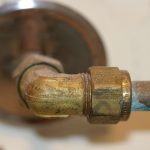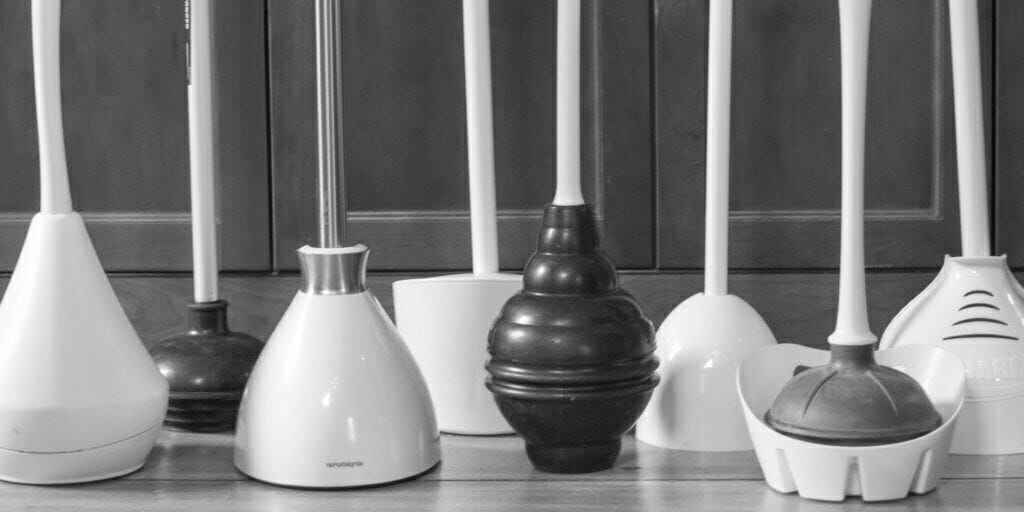Let’s face it; when a sink, tub or shower cannot drain the water away quickly enough, most people reach for the plunger. In many cases, using a plunger to clear a clog is a sound strategy, and a mechanical removal is always preferable over using caustic chemical cleaning products. Most people believe that there is only one type of plunger, but this is incorrect, and they may not know how to use them correctly. If a plunger is used in the wrong way, it could cause damage to the plumbing pipes, and this can lead to an expensive repair. In this article, we will tell you everything you need to know about plungers.
A Quick Overview
Most homes have a plunger somewhere in their home; it sits in a forgotten location, and then it’s dragged out every now and again to clear a clog. The humble plunger works by creating a change in air pressure in the plumbing pipe that moves backward and forwards to move the clog and loosen it. Generally speaking, there are three different types of plungers available; they are cup, flange, and accordion. Each type of plunger has its own unique characteristics making them more effective in certain situations. Below we will take a look at the pros and cons of each plunger type in detail.
The Cup Plunger
Although the name may be unfamiliar, the cup plunger is the style of plunger that most people have somewhere in their home. It’s basically a wooden or plastic handle with a cup shaped rubbed cup at the other end. This is the “go to” plunger for millions of people all over the world, and it’s very effective at clearing certain types of clogs. The cup plunger was primarily designed to unclog drains in sinks, tubs and the bottom of shower stalls. Pretty much any drain hole that is surrounded by a flat surface can be unclogged using a cup plunger unless the clog is persistent. A cup plunger is not a good choice for any drain system that has a curved or sloping surface like certain bowl sinks models and inside the toilet bowl. This is because the cup plunger needs to have a flat surface to create a tight seal before the suction to remove the clog can be created.
The Flange Plunger
Many people will not have heard of a flange plunger, and it’s not likely that they will have one in their home. But, if you need to clear clog in your toilet, a flange plunger may be able to help you solve the problem. At first glance, a flange plunger looks pretty similar to a cup plunger, but there is a key difference. If you take a look inside the cup at the business end, you will notice that there is a softer rubber flap that can fold out of the cup. This rubber flap allows the flange plunger to create a tight seal on a surface that isn’t flat. When you use the flange plunger in the toilet bowl, it can wedge onto the drainage hole at the bottom and allow you to apply pressure to clear a clog. The additional rubber flap can help you to create a vacuum on uneven surfaces, and this means that you can avoid calling out a plumber to deal with a minor clog.
The Accordion Plunger
It’s easier to think of the accordion plunger as an enhanced version of the flange plunger shown above. This type of plunger is typically made from molded black plastic with a ridged handle for extra grip. The handle is connected to an extended plunger head that has an accordion type body. This plunger shape body introduces extra pressure into the cup as you move the handle up and down to remove stubborn clogs. If you look inside the cup, you will notice the same soft rubber flap that extends around the entire rim. Again, this will allow the accordion plunger to make a seal on many types of surfaces where you need some extra plunger power. This is a good plunger to have if you experience harder to shift clogs on a regular basis.
Which Plunger Do You Need?
As you can see, each plunger is well suited to a slightly different task and which one you will need will vary on your own circumstances. That being said, each of these plungers isn’t that expensive to purchase, and they are readily available at any hardware store. If you want to be prepared for any clog, it’s a good idea to get all three and put them in your plumbing toolkit. Having the right plunger on hand is a great way to avoid calling a plumber to clear a clog. It’s true that you could go out and buy a plunger when you need one. But, clogs always seem to block a drain at the worst times when you need to get to work, or you cannot get to the store.
Avoid Using Chemical Drain Cleaners
There are many chemical drain cleaning products available to clear clogs. These usually come in a granular form and you pour them into the drain and then flush with water to clear the clog. These products can work for a time, but the clog often returns, and you have to repeat the process over again. The worst thing about these drain cleaners is that they contain caustic chemicals that can burn your skin if it comes into contact with them. These caustic chemical properties also cause damage to the plumbing pipes in your home, and persistent use could lead to an expensive repair. A manual clog removal is always the best solution, and the chance of the clog returning is lower unless you have an underlying problem.
If you’ve tried to use one or more of your plungers to clear a clog and you cannot get rid of it, call a
local certified plumber. They have the training, experience, and specialized tools to remove the clog without damaging your plumbing systems.
By Giovanni Longo President Flood Brothers Plumbing
Giovanni Longo is a 3rd generation master plumber who has been practicing his craft and trade in the greater Los Angeles area for well over a decade and a half. A plumbing and hydraulics-engineering innovator, Giovanni’s particular world-class expertise focuses on dealing with challenging sewer system designs as well as resolving complex commercial and residential draining issues. As a certified Flood Mitigation expert, he is also well versed in a wide variety of water damage and remediation solution.





